Variation in Hydraulic Properties of Forest Soils in Temperate Climate Zones
Abstract
1. Introduction
2. Materials and Methods
2.1. Nature and Classification of the Studies
2.2. Statistical Analysis
3. Results
3.1. Soil Water Retention
3.2. Soil Bulk Density
3.3. Soil Saturated Hydraulic Conductivity
4. Discussion
5. Conclusions
- We found hardly any articles addressing SHP and describing an appropriate number of site parameters simultaneously in the reviewed studies, which made it difficult to determine the impact of forest type and age on soil hydraulic properties.
- The main purpose of many of the screened articles was not specifically to assess the SHP, which were measured as additional information; possibly one of the reasons why many parameters of interest for our analysis were poorly detailed.
- The great variability in results in the reviewed studies underlines the belief that SHP can be sensitive to a wide range of site parameters. Due to an incomplete description of the study site’s conditions and differences in methodologies applied for each author (different measuring devices, diversity of sampling design, and inappropriate comparisons), there is not enough evidence to draw sophisticated conclusions in terms of the influence of specific forest characteristics (type and age) on SHP.
- Due to the large gap of knowledge in the literature and the abovementioned arguments, we were neither able to accept nor reject our hypothesis.
Author Contributions
Funding
Data Availability Statement
Conflicts of Interest
References
- Allen, C.D.; Breshears, D.D.; McDowell, N.G. On underestimation of global vulnerability to tree mortality and forest die-off from hotter drought in the Anthropocene. Ecosphere 2015, 6, 129. [Google Scholar] [CrossRef]
- Allen, C.D.; Macalady, A.K.; Chenchouni, H.; Bachelet, D.; McDowell, N.; Vennetier, M.; Kitzberger, T.; Rigling, A.; Breshears, D.D.; Hogg, E.H.; et al. A global overview of drought and heat-induced tree mortality reveals emerging climate change risks for forests. For. Ecol. Manag. 2010, 259, 660–684. [Google Scholar] [CrossRef]
- European Commission, Eurostat. Forestry in the EU and the World: A Statistical Portrait 2011. Available online: https://data.europa.eu/doi/10.2785/13022 (accessed on 20 October 2021).
- Lindner, M.; Maroschek, M.; Netherer, S.; Kremer, A.; Barbati, A.; Garcia-Gonzalo, J.; Seidl, R.; Delzon, S.; Corona, P.; Kolström, M.; et al. Climate change impacts, adaptive capacity, and vulnerability of European forest ecosystems. For. Ecol. Manag. 2010, 259, 698–709. [Google Scholar] [CrossRef]
- Pretzsch, H.; Steckel, M.; Heym, M. Stand growth and structure of mixed-species and monospecific stands of Scot pine (Pinus sylvestris L.) and oak (Q. robur L., Quercus petraea (MATT.) LIEBL.) analysed along a productivity gradient through Europe. Eur. J. For. Res. 2020, 139, 349–367. [Google Scholar] [CrossRef]
- Seiwa, K.; Kunii, D.; Masaka, K.; Hayashi, S.; Tada, C. Hardwood mixture enhances soil water infiltration in a conifer plantation. For. Ecol. Manag. 2021, 498, 119508. [Google Scholar] [CrossRef]
- Wahl, N.A.; Bens, O.; Schäfer, B.; Hüttl, R.F. Impact of changes in land-use management on soil hydraulic properties: Hydraulic conductivity, water repellency and water retention. Phys. Chem. Earth 2003, 28, 1377–1387. [Google Scholar] [CrossRef]
- Wahl, N.A.; Wöllecke, B.; Bens, O.; Hüttl, R.F. Can forest transformation help reducing floods in forested watersheds? Certain aspects on soil hydraulics and organic matter properties. Phys. Chem. Earth 2005, 30, 611–621. [Google Scholar] [CrossRef]
- Tor-Ngern, P.; Oishi, A.C.; Uebelherr, J.M.; Palmroth, S.; Tarvainen, L.; Ottoson-Löfvenius, M.; Linder, S.; Domec, J.C.; Näsholm, T. Ecophysiological variation of transpiration of pine forests: Synthesis of new and published results. Ecol. Appl. 2017, 27, 118–133. Available online: http://www.jstor.org/stable/44132586 (accessed on 11 October 2021). [CrossRef]
- Meusburger, K.; Trotsiuk, V.; Schmidt-Walter, P.; Baltensweiler, A.; Brun, P.; Bernhard, F.; Gharun, M.; Habel, R.; Hagedorn, F.; Köchli, R.; et al. Soil-plant interactions modulated water availability of Swiss forests during the 2015 and 2018 droughts. Glob. Chang. Biol. 2022, 28, 5928–5944. [Google Scholar] [CrossRef]
- Schmidt-Walter, P.; Trotsiuk, V.; Meusburger, K.; Zacios, M.; Meesenburg, H. Advancing simulations of water fluxes, soil moisture and drought stress by using the LWF-Brook90 hydrological model in R. Agric. For. Meteorol. 2020, 291, 108023. [Google Scholar] [CrossRef]
- Assouline, S.; Or, D. Conceptual and parametric representation of soil hydraulic properties: A review. Vadose Zone J. 2013, 12, 1–20. [Google Scholar] [CrossRef]
- Weninger, T.; Bodner, G.; Kreiselmeier, J.; Chandrasekhar, P.; Julich, S.; Feger, K.-H.; Schwärzel, K.; Schwen, A. Combination of measurement methods for a wide range description of hydraulic soil properties. Water 2018, 10, 1021. [Google Scholar] [CrossRef]
- Archer, N.A.L.; Otten, W.; Schmidt, S.; Bengough, A.G.; Shah, N.; Bonell, M. Rainfall infiltration and soil hydrological characteristics below ancient forest, planted Forest and Grassland in a Temperate Northern Climate. Ecohydrology 2016, 9, 585–600. [Google Scholar] [CrossRef]
- Chandler, K.R.; Stevens, C.J.; Binley, A.; Keith, A.M. Influence of tree species and forest land use on soil hydraulic conductivity and implications for surface runoff generation. Geoderma 2018, 310, 120–127. [Google Scholar] [CrossRef]
- Julich, S.; Kreiselmeier, J.; Scheibler, S.; Petzold, R.; Schwärzel, K.; Feger, K.H. Hydraulic properties of forest soils with stagnic conditions. Forests 2021, 12, 1113. [Google Scholar] [CrossRef]
- Wahren, A.; Schwärzel, K.; Feger, K.H. Potentials and limitations of natural flood retention by forested land in headwater catchments: Evidence from experimental and model studies. J. Flood Risk Manag. 2012, 5, 321–335. [Google Scholar] [CrossRef]
- Liu, Y. A numerical study on hydrological impacts of forest restoration in the southern United States. Ecohydrology 2011, 4, 299–314. [Google Scholar] [CrossRef]
- Bogunovic, I.; Viduka, A.; Magdic, I.; Telak, L.J.; Francos, M.; Pereira, P. Agricultural and forest land-use impact on soil properties in Zagreb periurban area (Croatia). Agronomy 2020, 10, 1331. [Google Scholar] [CrossRef]
- Archer, N.A.L.; Bonell, M.; MacDonald, A.M.; Coles, N. A Constant Head Well Permeameter Formula Comparison: Its Significance in the Estimation of Field-Saturated Hydraulic Conductivity in Heterogeneous Shallow Soils. Hydrol. Res. 2014, 45, 788–805. [Google Scholar] [CrossRef][Green Version]
- Bens, O.; Wahl, N.A.; Fischer, H.; Hüttl, R.F. Water infiltration and hydraulic conductivity in sandy cambisols: Impacts of forest transformation on soil hydrological properties. Eur. J. For. Res. 2007, 126, 101–109. [Google Scholar] [CrossRef]
- Bauwe, A.; Koch, M.; Kallweit, R.; Konopatzky, A.; Strohbach, B.; Lennartz, B. Tree-ring growth response of Scots pine (Pinus sylvestris L.) to climate and soil water availability in the lowlands of north-eastern Germany. Balt. For. 2013, 19, 212–225. Available online: https://www.researchgate.net/publication/260435722 (accessed on 20 October 2021).
- Gebauer, T.; Horna, V.; Leuschner, C. Canopy transpiration of pure and mixed forest stands with variable abundance of European beech. J. Hydrol. 2012, 442–443, 2–14. [Google Scholar] [CrossRef]
- Meinzer, F.C.; Woodruff, D.R.; Eissenstat, D.M.; Lin, H.S.; Adams, T.S.; McCulloh, K.A. Above- and belowground controls on water use by trees of different wood types in an eastern US deciduous forest. Tree Physiol. 2013, 33, 345–356. [Google Scholar] [CrossRef]
- Aranda, I.; Forner, A.; Cuesta, B.; Valladares, F. Species-Specific Water Use by Forest Tree Species: From the Tree to the Stand. Agric. Water Manag. 2012, 114, 67–77. [Google Scholar] [CrossRef]
- Knutzen, F.; Meier, I.C.; Leuschner, C. Does reduced precipitation trigger physiological and morphological drought adaptations in European beech (Fagus sylvatica L.)? Comparing provenances across a precipitation gradient. Tree Physiol. 2015, 35, 949–963. [Google Scholar] [CrossRef]
- Wang, Y.; Dong, X.; Wang, H.; Wang, Z.; Gu, J. Root trip morphology, anatomy, chemistry and potential hydraulic conductivity vary with soil depth in three temperate hardwood species. Tree Physiol. 2015, 36, 99–108. [Google Scholar] [CrossRef]
- Christiansen, J.; Vesterdal, L.; Callesen, I.; Elberling, B.; Schmidt, I.K.; Gundersen, P. Role of six European tree species and land-use legacy for nitrogen and water budgets in forests. Glob. Chang. Biol. 2010, 16, 2224–2240. [Google Scholar] [CrossRef]
- Frêne, C.; Dörner, J.; Zúñiga, F.; Cuevas, J.G.; Alfaro, F.D.; Armesto, J.J. Eco-hydrological functions in forested catchments of Southern Chile. Ecosystems 2020, 23, 307–323. [Google Scholar] [CrossRef]
- Hansson, K.; Olsson, B.A.; Olsson, M.; Johansson, U.; Kleja, D.B. Differences in soil properties in adjacent stands of Scots pine, Norway spruce and Silver birch in SW Sweden. For. Ecol. Manag. 2011, 262, 522–530. [Google Scholar] [CrossRef]
- Norman, J.S.; Barrett, J.E. Substrate and nutrient limitation of ammonia-oxidizing bacteria and archaea in temperate forest soil. Soil Biol. Biochem. 2014, 69, 141–146. [Google Scholar] [CrossRef]
- Schiff, S.L.; Devito, K.J.; Elgood, R.J.; McCrindle, P.M.; Spoelstra, J.; Dillon, P. Two adjacent forested catchments: Dramatically different NO3− export. Water Resour. Res. 2002, 38, 28-1–28-13. [Google Scholar] [CrossRef]
- Błońska, E.; Klamerus-Iwan, A.; Lasota, J.; Gruba, P.; Pach, M.; Pretzsch, H. What characteristics of soil fertility can improve in mixed stands of Scots pine and European beech compared with monospecific stands? Commun. Soil Sci. Plant Anal. 2018, 49, 237–247. [Google Scholar] [CrossRef]
- Kopler, I.; Burg, D.; Wittenberg, L.; Malkinson, D. Differences in soil moisture in two middle eastern oak forests: Comparing the effects of trees and soil composition. Hydrol. Process. 2019, 33, 86–100. [Google Scholar] [CrossRef]
- Maes, S.L.; Blondeel, H.; Perring, M.P.; Depauw, L.; Brümelis, G.; Brunet, J.; Decocq, G.; den Ouden, J.; Härdtle, W.; Hédl, R.; et al. Litter quality, land-use history, and nitrogen deposition effects on topsoil conditions across European temperate deciduous forests. For. Ecol. Manag. 2019, 433, 405–418. [Google Scholar] [CrossRef]
- Farahnak, M.; Mitsuyasu, K.; Jeong, S.; Otsuki, K.; Chiwa, M.; Sadeghi, S.M.M.; Kume, A. Soil hydraulic conductivity differences between upslope and downslope of two coniferous trees on a hillslope. J. For. Res. 2019, 3, 143–152. [Google Scholar] [CrossRef]
- Jost, G.; Schume, H.; Hager, H.; Markart, G.; Kohl, B. A hillslope scale comparison of tree species influence on soil moisture dynamics and runoff processes during intense rainfall. J. Hydrol. 2012, 420–421, 112–124. [Google Scholar] [CrossRef]
- Lange, B.; Germann, P.F.; Lüscher, P. Greater abundance of Fagus sylvatica in coniferous flood protection forests due to climate change: Impact of modified root densities on infiltration. Eur. J. For. Res. 2013, 132, 151–163. [Google Scholar] [CrossRef]
- Moher, D.; Liberati, A.; Tetzlaff, J.; Altman, D.G.; The Prisma Group. Preferred reporting items for systematic reviews and meta-analyses: The PRISMA statement. Int. J. Surg. 2010, 8, 336–341. [Google Scholar] [CrossRef]
- Bittner, S.; Talkner, U.; Krämer, I. Modeling stand water budgets of mixed temperate broad-leaved forest stands by considering variations in species specific drought response. Agric. For. Meteorol. 2010, 150, 1347–1357. [Google Scholar] [CrossRef]
- Grant, R.F.; Zhang, Y.; Yuan, F.; Wang, S.; Hanson, P.J.; Gaumont-Guay, D.; Chen, J.; Black, T.A.; Barr, A.; Baldocchi, D.D.; et al. Intercomparison of techniques to model water stress effects on CO2 and energy exchange in temperate and boreal deciduous forests. Ecol. Model. 2006, 196, 289–312. [Google Scholar] [CrossRef]
- Metzger, J.C.; Wutzler, T.; Valle, N.D.; Filipzik, J.; Grauer, C.; Lehmann, R.; Roggenbuck, M.; Schelhorn, D.; Weckmüller, J.; Küsel, K.; et al. Vegetation impacts soil water content patterns by shaping canopy water fluxes and soil properties. Hydrol. Process. 2017, 31, 3783–3795. [Google Scholar] [CrossRef]
- Baldocchi, D.D.; Law, B.E.; Anthoni, P.M. On measuring and modeling energy fluxes above the floor of a homogeneous and heterogeneous conifer forest. Agric. For. Meteorol. 2000, 102, 187–206. [Google Scholar] [CrossRef]
- Dusek, J.; Vogel, T. Hillslope hydrograph separation: The effects of variable isotopic signatures and hydrodynamic mixing in macroporous soil. J. Hydrol. 2018, 563, 446–459. [Google Scholar] [CrossRef]
- Almahayni, T.; Houska, T. Towards dynamic and process–based modelling of radionuclides cycling in terrestrial radioecology. J. Environ. Radioact. 2020, 225, 106380. [Google Scholar] [CrossRef] [PubMed]
- Duarte, H.F.; Raczka, B.M.; Ricciuto, D.M.; Lin, J.C.; Koven, C.D.; Thornton, P.E.; Bowling, D.R.; Lai, C.; Bible, K.J.; Ehleringer, J.R. Evaluating the Community Land Model (CLM4.5) at a coniferous forest site in northwestern United States using flux and carbon-isotope measurements. Biogeosciences 2017, 14, 4315–4340. [Google Scholar] [CrossRef]
- Kirchen, G.; Calvaruso, C.; Granier, A.; Redon, P.O.; Van der Heijden, G.; Bréda, N.; Turpault, M.P. Local soil type variability controls the water budget and stand productivity in a beech forest. For. Ecol. Manag. 2017, 390, 89–103. [Google Scholar] [CrossRef]
- Leuschner, C. Water extraction by tree fine roots in the forest floor of a temperate Fagus-Quercus forest. Ann. For. Sci. 1998, 55, 141–157. [Google Scholar] [CrossRef]
- Curiel, J.; Janssens, I.A.; Carrara, A.; Ceulemans, R. Annual Q10 of soil respiration reflects plant phenological patterns as well as temperature sensitivity. Glob. Chang. Biol. 2004, 10, 161–169. [Google Scholar] [CrossRef]
- Schwärzel, K.; Menzer, A.; Clausnitzer, F. Soil water content measurements deliver reliable estimates of water fluxes: A comparative study in a beech and a spruce stand in the Tharandt forest (Saxony, Germany). Agric. For. Meteorol. 2009, 149, 1994–2006. [Google Scholar] [CrossRef]
- Bakhshandeh-Navroud, B.; Abrari, V.K.; Pilehvar, B.; Kooch, Y. The interactions between tree-herb layer diversity and soil properties in the oriental beech (Fagus Orientalis Lipsky) stands in Hyrcanian forest. Environ. Monit. Assess. 2018, 190, 425. [Google Scholar] [CrossRef]
- Moragues-Saitua, L.; Arias-González, A.; Gartzia-Bengoetxea, N. Effects of biochar and wood ash on soil hydraulic properties: A field experiment involving contrasting temperate soils. Geoderma 2017, 305, 144–152. [Google Scholar] [CrossRef]
- Polláková, N.; Šimanský, V.; Jonczak, J. Characteristics of physical properties in soil profiles under selected introduced trees in the nature reserve Arboretum Mlyňany, Slovakia. Folia Oecologica 2017, 44, 78–86. [Google Scholar] [CrossRef]
- Rosenkranz, P.; Dannenmann, M.; Brüggemann, N.; Papen, H.; Berger, U.; Zumbusch, E.; Butterbach-Bahl, K. Gross rates of ammonification and nitrification at a nitrogen-saturated Spruce (Picea abies (L.) Karst.) stand in southern Germany. Eur. J. Soil Sci. 2010, 61, 745–758. [Google Scholar] [CrossRef]
- Link, T.E.; Flerchinger, G.N.; Unsworth, M.; Marks, D. Simulation of water and energy fluxes in an old-growth seasonal temperate rain forest using the simultaneous heat and water (SHAW) model. J. Hydrometeorol. 2004, 5, 443–457. [Google Scholar] [CrossRef]
- Frey, B.; Niklaus, P.A.; Kremer, J.; Lüscher, P.; Zimmermann, S. Heavy-machinery traffic impacts methane emissions as well as methanogen abundance and community structure in oxic forest soils. Appl. Environ. Microbiol. 2011, 77, 6060–6068. [Google Scholar] [CrossRef]
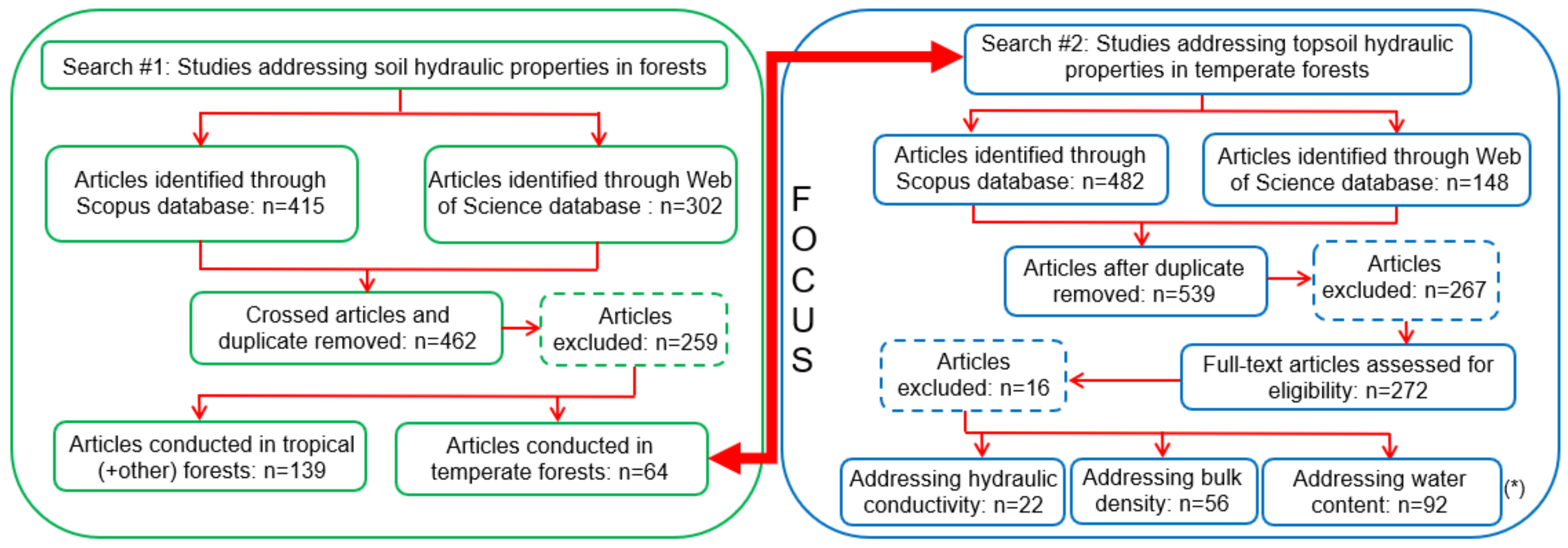
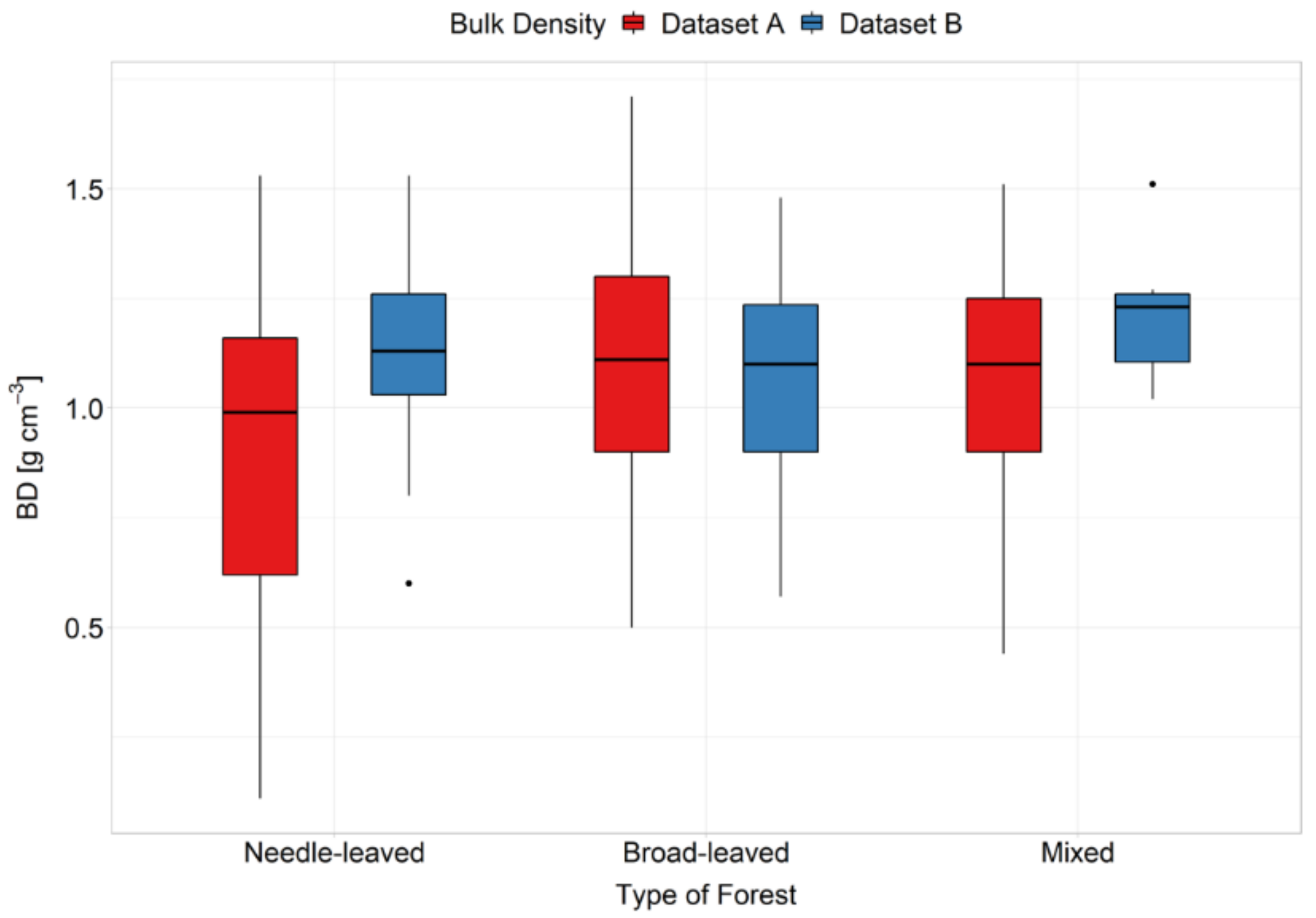
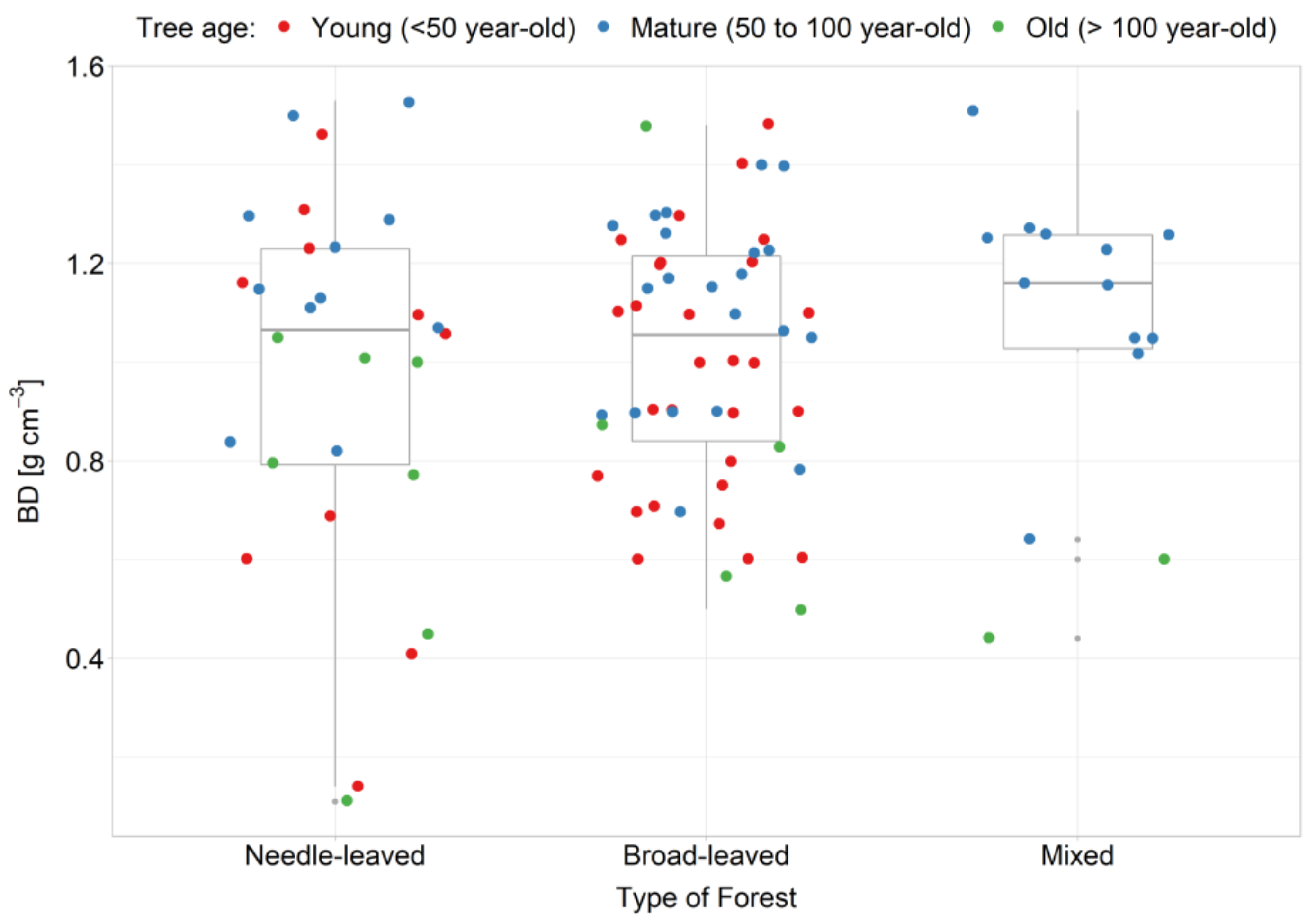
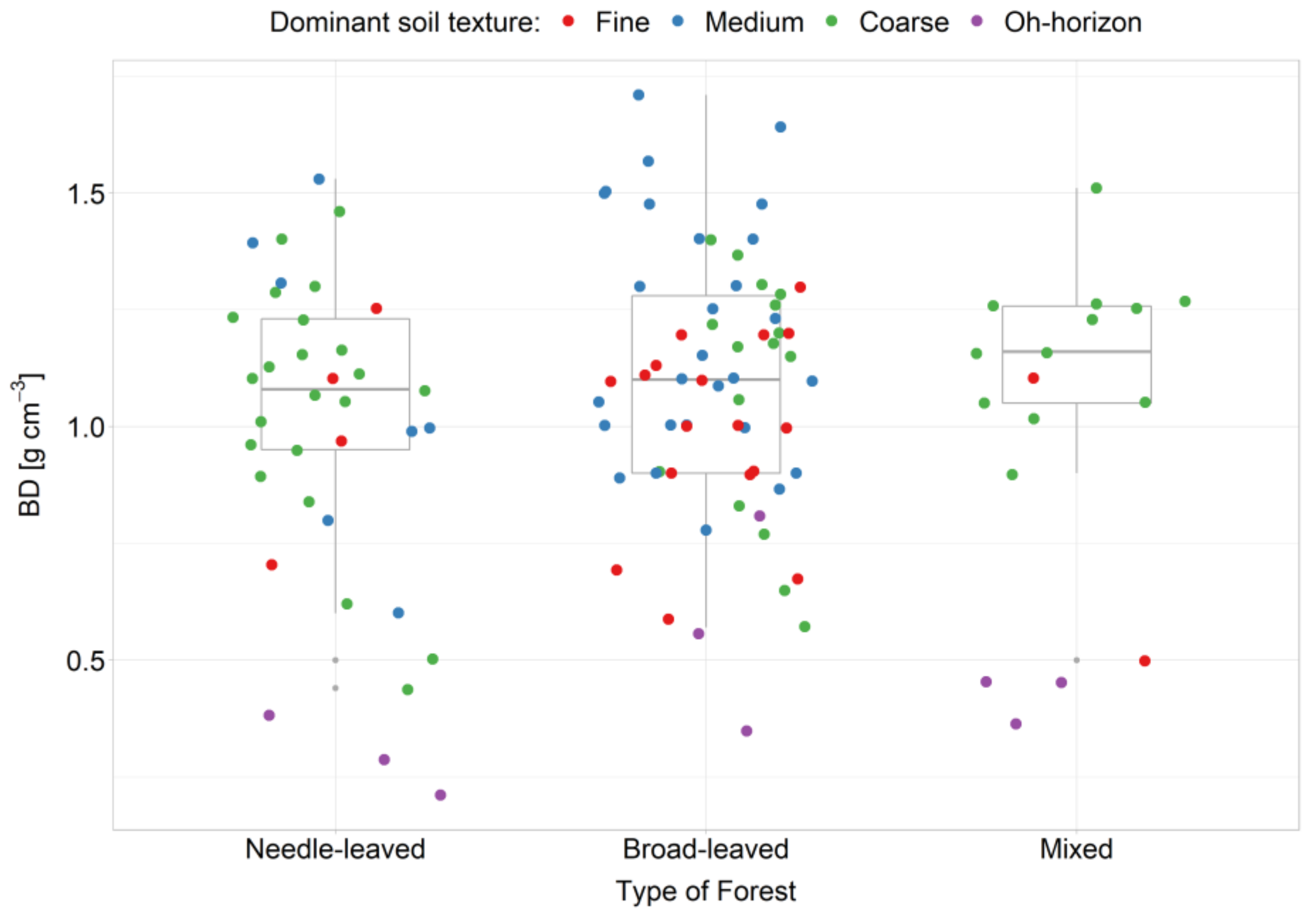
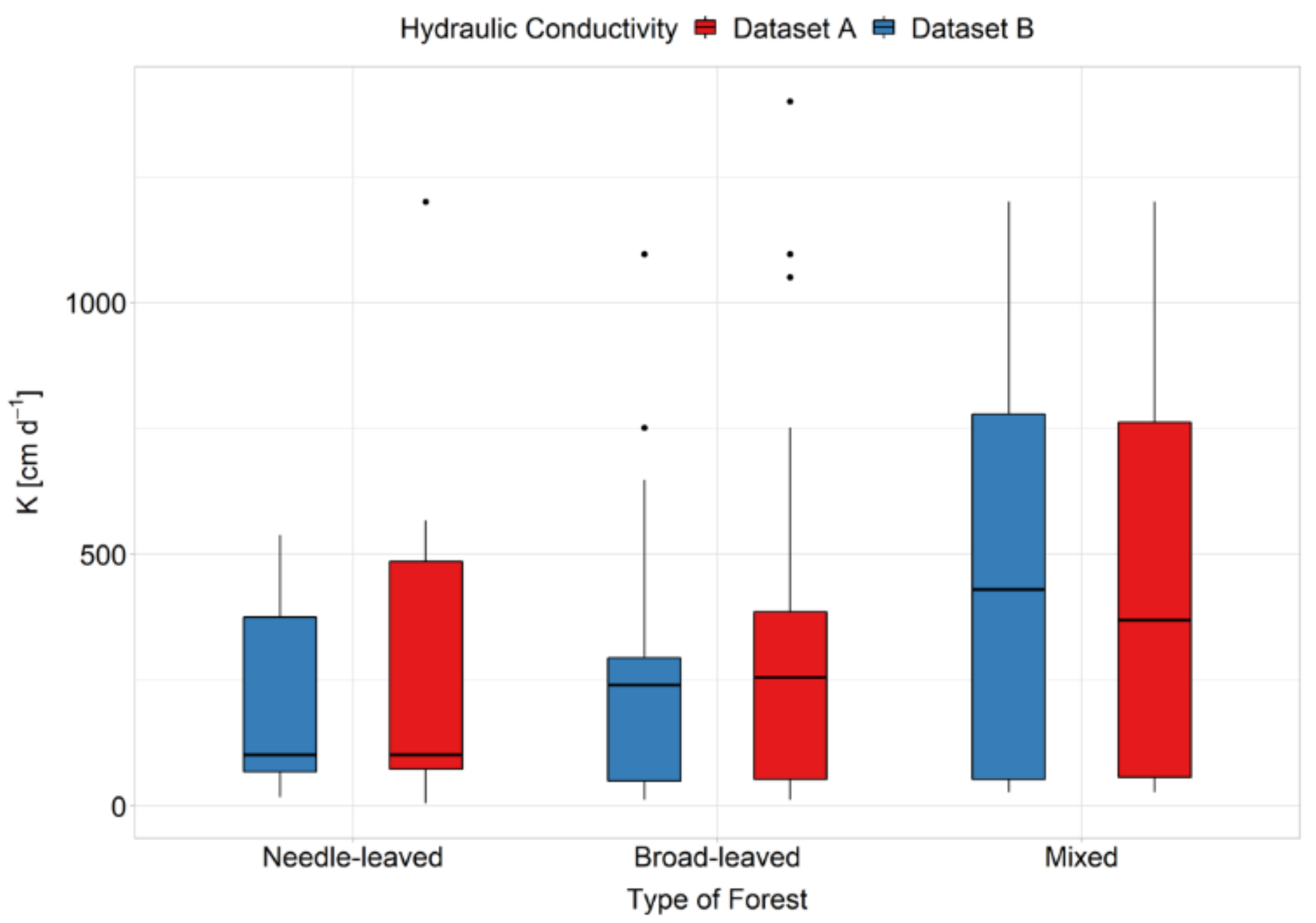
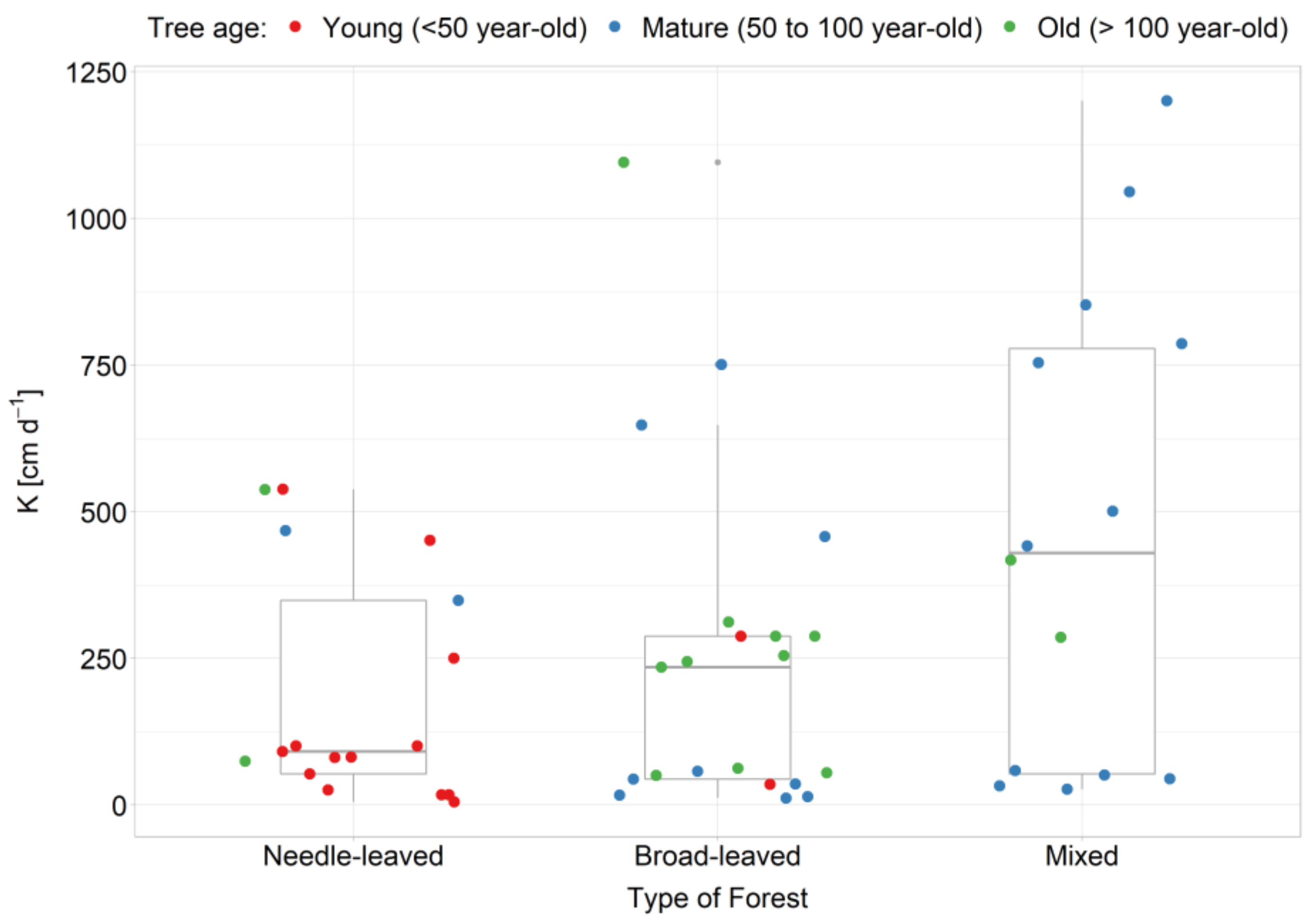

| Needle-Leaved Forest | |||||||||
|---|---|---|---|---|---|---|---|---|---|
| (a) K | Young | Mature | Old | Total | (b) BD | Young | Mature | Old | Total |
| Coarse | 10 | 1 | 0 | 11 | Coarse | 4 | 11 | 2 | 17 |
| Medium | 0 | 1 | 0 | 1 | Medium | 2 | 1 | 2 | 5 |
| Fine | 0 | 0 | 0 | 0 | Fine | 0 | 0 | 0 | 0 |
| Total | 10 | 2 | 0 | 12 | Total | 6 | 12 | 4 | 22 |
| Broad-Leaved Forest | |||||||||
| Coarse | 0 | 6 | 9 | 15 | Coarse | 2 | 12 | 2 | 16 |
| Medium | 1 | 4 | 0 | 5 | Medium | 3 | 1 | 12 | 16 |
| Fine | 0 | 0 | 0 | 0 | Fine | 11 | 0 | 0 | 11 |
| Total | 1 | 10 | 9 | 20 | Total | 16 | 13 | 14 | 43 |
| Mixed Forest | |||||||||
| Coarse | 0 | 12 | 2 | 14 | Coarse | 0 | 14 | 0 | 14 |
| Medium | 0 | 0 | 0 | 0 | Medium | 0 | 0 | 0 | 0 |
| Fine | 0 | 0 | 0 | 0 | Fine | 0 | 0 | 0 | 0 |
| Total | 0 | 12 | 2 | 14 | Total | 0 | 14 | 0 | 14 |
| Author References | FC 1 | PAW 2 | PWP 3 | Forest Type | Soil Texture Class | Tree Age |
|---|---|---|---|---|---|---|
| (m3 m−3) | ||||||
| Bittner et al. [40] | - | - | 0.06 | Broa | Silty clay | Old |
| - | - | 0.06 | Broa | Silty clay | Old | |
| - | - | 0.09 | Broa | Silty clay | Old | |
| Grant et al. [41] | 0.28 | 0.09 | - | Broa | Silty | Mature |
| Metzger et al. [42] | 0.44 | - | - | Broa | Fine textured | - |
| 0.42 | - | - | Broa | Fine textured | - | |
| Baldocchi et al. [43] | 0.16 | - | - | Nee | Sandy | Old |
| Archer et al. [14] | - | 0.290 | - | Nee | Sandy | Young |
| - | 0.240 | - | Nee | Sandy | Mature | |
| - | 0.220 | - | Nee | Sandy | Old | |
| - | 0.180 | - | Nee | Sandy | Old | |
| Dusek and Vogel [44] | - | - | 0.20 | Nee | Sandy | - |
| - | - | 0.20 | Nee | Sandy | - | |
| Tor-Ngern et al. [9] | 0.15 | - | - | Nee | Sandy | Young |
| 0.15 | - | 0.05 | Nee | Sandy | Mature | |
| Almahayni and Houska [45] | 0.12 | 0.02 | - | Nee | Sandy | - |
| Duarte et al. [46] | 0.30 | - | 0.14 | Nee | - | Old |
| Kirchen et al. [47] | 0.40 | - | 0.18 | Broa | Fine textured | Young |
| 0.40 | - | 0.28 | Broa | Fine textured | Young | |
| 0.31 | - | 0.15 | Broa | Fine textured | Young | |
| 0.34 | - | 0.17 | Broa | Fine textured | Young | |
| Leuschner [48] | - | 0.32 | 0.13 | Broa | Sandy | - |
| - | 0.14 | 0.13 | Nee | - | Young | |
| Curiel Yuste et al. [49] | 0.12 | - | - | Mix | Sandy | - |
| Julich et al. [16] | 0.43 | 0.29 | 0.14 | Broa | Silty | Young |
| 0.40 | 0.29 | 0.11 | Broa | Silty | Old | |
| 0.40 | 0.30 | 0.10 | Nee | Silty | Mature | |
| Wahren et al. [17] | - | 0.22 | - | Mix | Sandy loam | Mature |
| Schwärzel et al. [50] | - | 0.27 | - | Broa | Silty | Mature |
| - | 0.33 | - | Nee | Silty | Old | |
| Bulk Density (g cm−3) | ||||||
|---|---|---|---|---|---|---|
| Forest Type | n | Mean | Min | Max | p-Value | |
| A | Needle-leaved | 45 | 0.89 | 0.11 | 1.53 | 0.0098 (*) |
| Broad-leaved | 83 | 1.09 | 0.50 | 1.71 | 0.2396 | |
| Mixed | 17 | 1.02 | 0.44 | 1.51 | 0.4682 | |
| B | Needle-leaved | 19 | 1.12 | 0.60 | 1.53 | 0.5807 |
| Broad-leaved | 40 | 1.10 | 0.57 | 1.48 | 0.3541 | |
| Mixed | 11 | 1.20 | 1.02 | 1.51 | 0.1241 | |
| Hydraulic Conductivity (cm d−1) | ||||||
| Forest Type | n | G. Mean | Min | Max | p-Value | |
| A | Needle-leaved | 20 | 132 | 6 | 1200 | 0.9806 |
| Broad-leaved | 23 | 160 | 12 | 1400 | 0.4261 | |
| Mixed | 16 | 224 | 27 | 1201 | 0.3460 | |
| B | Needle-leaved | 12 | 116 | 17 | 538 | 0.9379 |
| Broad-leaved | 20 | 127 | 12 | 1096 | 0.1498 | |
| Mixed | 14 | 239 | 27 | 1201 | 0.1415 | |
| Bulk Density (g cm−3) | Needle-Leaved | Broad-Leaved | Mixed | ||||||
|---|---|---|---|---|---|---|---|---|---|
| Tree age | Y | M | O | Y | M | O | Y | M | O |
| mean values | 0.92 | 1.18 | 0.74 | 0.98 | 1.11 | 0.85 | - | 1.16 | 0.52 |
| n | 10 | 11 | 7 | 28 | 21 | 5 | - | 12 | 2 |
| max | 1.46 | 1.53 | 1.05 | 1.48 | 1.40 | 1.48 | - | 1.51 | 0.60 |
| min | 0.14 | 0.82 | 0.11 | 0.60 | 0.70 | 0.50 | - | 0.64 | 0.44 |
| Hydraulic Conductivity (cm d−1) | Needle-Leaved | Broad-Leaved | Mixed | ||||||
| Tree age | Y | M | O | Y | M | O | Y | M | O |
| mean values | 140 | 409 | 306 | 692 | 171 | 233 | - | 483 | 352 |
| n | 13 | 2 | 2 | 2 | 9 | 10 | - | 12 | 2 |
| max | 538 | 468 | 538 | 1096 | 312 | 751 | - | 1201 | 418 |
| min | 6 | 349 | 75 | 288 | 35 | 12 | - | 27 | 286 |
| Bulk Density (g cm−3) | Needle-Leaved | Broad-Leaved | Mixed | ||||||||||
|---|---|---|---|---|---|---|---|---|---|---|---|---|---|
| Soil texture | C | M | F | Oh | C | M | F | Oh | C | M | F | Oh | |
| mean values | 1.04 | 1.09 | 1.01 | 0.29 | 1.08 | 1.20 | 1.00 | 0.57 | 1.18 | - | 0.80 | 0.42 | |
| n | 22 | 7 | 4 | 3 | 16 | 28 | 17 | 3 | 12 | - | 2 | 3 | |
| max | 1.46 | 1.53 | 1.25 | 0.38 | 1.40 | 1.71 | 1.30 | 0.81 | 1.51 | - | 1.10 | 0.45 | |
| min | 0.44 | 0.60 | 0.70 | 0.21 | 0.57 | 0.78 | 0.59 | 0.35 | 0.90 | - | 0.50 | 0.36 | |
| Hydraulic Conductivity (cm d−1) | Needle-Leaved | Broad-Leaved | Mixed | ||||||||||
| Soil texture | C | M | F | Oh | C | M | F | Oh | C | M | F | Oh | |
| mean values | 204 | 261 | 875 | - | 242 | 286 | 1225 | - | 464 | 320 | 64 | - | |
| n | 13 | 2 | 2 | - | 17 | 5 | 2 | - | 14 | 1 | 1 | - | |
| max | 567 | 468 | 1200 | - | 751 | 1096 | 1400 | - | 1201 | - | - | - | |
| min | 17 | 53 | 550 | - | 35 | 12 | 1050 | - | 27 | - | - | - | |
Publisher’s Note: MDPI stays neutral with regard to jurisdictional claims in published maps and institutional affiliations. |
© 2022 by the authors. Licensee MDPI, Basel, Switzerland. This article is an open access article distributed under the terms and conditions of the Creative Commons Attribution (CC BY) license (https://creativecommons.org/licenses/by/4.0/).
Share and Cite
Virano-Riquelme, V.; Feger, K.-H.; Julich, S. Variation in Hydraulic Properties of Forest Soils in Temperate Climate Zones. Forests 2022, 13, 1850. https://doi.org/10.3390/f13111850
Virano-Riquelme V, Feger K-H, Julich S. Variation in Hydraulic Properties of Forest Soils in Temperate Climate Zones. Forests. 2022; 13(11):1850. https://doi.org/10.3390/f13111850
Chicago/Turabian StyleVirano-Riquelme, Victoria, Karl-Heinz Feger, and Stefan Julich. 2022. "Variation in Hydraulic Properties of Forest Soils in Temperate Climate Zones" Forests 13, no. 11: 1850. https://doi.org/10.3390/f13111850
APA StyleVirano-Riquelme, V., Feger, K.-H., & Julich, S. (2022). Variation in Hydraulic Properties of Forest Soils in Temperate Climate Zones. Forests, 13(11), 1850. https://doi.org/10.3390/f13111850






